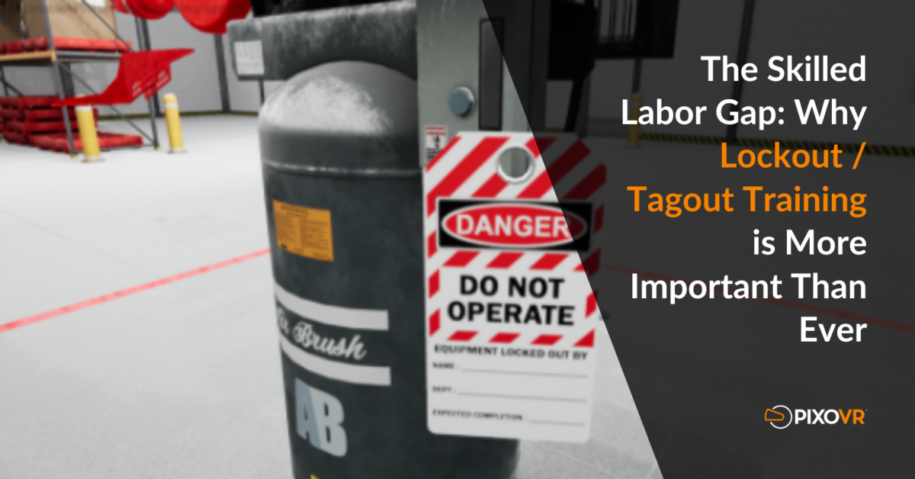Lockout / tagout (LOTO) training is important for any employees who work on or near equipment that could cause injury if it were accidentally energized or started up while they were performing maintenance or repair work. This includes equipment such as machinery, electrical panels, and other types of systems that could pose a hazard if they were to start up unexpectedly.
Unfortunately, as the skilled labor gap increased, more companies had to do their best to hire and train unskilled labor for these types of positions. The resulting impact is that lockout tagout mistakes are now one of the most frequently cited violations by OSHA inspectors.
It is difficult to accurately estimate the number of injuries that occur each year due to lockout/tagout (LOTO) mistakes, however, electrical injuries and deaths continue to increase as workers returned to work after the pandemic.
LOTO procedures are an important part of workplace safety, but today’s unskilled workers and younger workers need different teaching methods to truly learn these important steps. That’s where virtual reality can help. Virtual reality (VR) has been proven to be more effective for learning labor and safety skills. That’s because VR allows workers to practice those skills in a realistic environment. Read on for the details on how companies can help keep those needing to perform LOTO safer with VR training.
Who are candidates for LOTO VR training?
LOTO training is typically required for employees who are responsible for performing maintenance or repair work on equipment that is locked out or tagged out. It is also important for employees who may be present in the area where maintenance or repair work is being performed and could potentially be injured if the equipment were to start up unexpectedly.
The most common jobs that may require LOTO training include:
- Maintenance workers: These employees are responsible for repairing and maintaining equipment, and may be required to lock out or tag out equipment while they are working on it.
- Electricians: Electricians may be required to perform LOTO procedures when working on electrical panels or other electrical equipment.
- Machinery operators: Employees who operate machinery may be required to perform LOTO procedures when performing maintenance or repair work on the machinery.
- Industrial workers: Workers in industries such as manufacturing, construction, and oil and gas may be required to perform LOTO procedures when working on equipment that could pose a hazard if it were to start up unexpectedly.
Looking at this list, it makes sense that the skilled labor gap has impacted electrical safety. All of these jobs and industries have been impacted by a lack of skilled labor. That means a younger, less skilled workforce is becoming more common in these positions. Luckily, VR is highly engaging and more effective than other training methods. This makes it a great fit for helping companies to train their workforce on LOTO procedures.
LOTO VR training is already being used across industries
A good LOTO training program should cover the proper procedures for locking out or tagging out equipment, as well as the proper use of LOTO devices and other safety equipment. It should also include information on the hazards associated with the equipment being worked on, and the steps that should be taken to prevent accidents and injuries.
Lockout/Tagout VR training already exists that has been used by many companies in industries like construction, manufacturing, and utilities. The VR LOTO training covers things like:
- Identifying situations and equipment that require LOTO.
- Learning the correct order of operations in a LOTO procedure.
- Properly notifying other workers as needed throughout the LOTO process.
- The safety procedures to follow during equipment maintenance or repair.
- The appropriate procedures to return a machine to safe working order once it has been cleared for use.
The LOTO training also has an assessment module to evaluate the worker’s ability to properly perform Lockout/Tagout procedures.
Reducing electrical accidents is good for everyone
It is important for employers to provide LOTO training to their employees and to follow proper LOTO procedures to prevent injuries and accidents in the workplace. When VR is used for LOTO training, it has been shown to help reduce the number of accidents and their severity. Less accidents means big benefits for workers and their employers. Companies using VR for safety training realize:
- Higher output – getting unkilled labor trained and in the field is critical and VR training helps companies do that faster and better so companies get more work-hours.
- Lowered costs – when safety training is improved, less injuries occur. That means less money spent on disability claims, insurance payouts, and even litigation costs.
- Improved retention – unskilled labor is more likely to stay when companies are using VR for training as it is a more engaging and fun way to learn.
Using VR for LOTO training can increase safety and reduce costs. For any company looking to improve the company bottom line during the skilled labor gap and a questionable economy, VR safety training is a smart investment.
Wondering how to get started with VR training?
For learning and development leaders looking to help their company’s thrive, VR training is the answer. VR content naturally compliments existing training content to provide employees with ways to apply and practice skills needed to be successful.
Want more evidence for leadership on the cost cutting benefits of VR training? Read whitepaper here!
In our previous whitepaper we covered how to bring VR into your training program, get the step-by-step guide here!
Download the whitepaper: 5 Ways VR Training Helps Companies Even in an Economic Downturn’:


Leave a Reply
You must be logged in to post a comment.